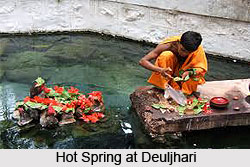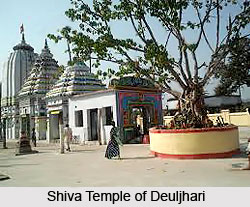 Deuljhari is a well-liked citadel of Shaivism. Deuljhari is situated in the Angul District, in the state of Odisha. This exquisite and splendid place has 24 acres and 55 decimals of land and is covered with jasmine and indigenous forest (Kiabana). The place is indeed very popular for the hot spring and a very ancient Shiva Shree Siddeswar Baba temple.
Deuljhari is a well-liked citadel of Shaivism. Deuljhari is situated in the Angul District, in the state of Odisha. This exquisite and splendid place has 24 acres and 55 decimals of land and is covered with jasmine and indigenous forest (Kiabana). The place is indeed very popular for the hot spring and a very ancient Shiva Shree Siddeswar Baba temple.
Hot spring of Deuljhari
Deuljhari hot spring water has its roots from below a Shiva linga that attaches a typical religious attribute to it. This hot spring water from Deuljhari spring is actually collected to a 36 man made ponds that circumscribe a Shiva Temple. Almost half of the springs of the region are cold springs that lie connected to the hot springs. This process is considered as a miracle of nature. It is believed that the waters of Deuljhari hot spring possess medical properties and has the capacity to heal number of diseases, and is useful for religious purposes as well. As per legends there are around eighty four such hot springs present. Most of these springs have been overshadowed by jasmine forest. Currently there are around 24 springs that are alive, out of which names like Agnikunda, Taptakunda, Himakunda, Amrutakunda and Labakusakunda are prominent ones. The temperatures prevailing in these springs vary from 40 degree Celsius to 62 degree Celsius.
Temple of Deuljhari
The area that covers the region of temples covers an area of 24 acres of land. The presiding deity, that adores the primary temple, is Sidheswar Baba. Some of the other significant temples that place boosts of are Kedareswar Baba, Enkari Mata Maa Mahaswari, Sri Maheswar Baba, Sri Jogeswar Baba and Maa Khambeswari.

The place has immense mythological significance as well. The place is linked to the age of Tretaya, where the Lord Rama, along with his wife, Sita and Laxman, his younger brother, worshiped Lord Shiva in course of their fourteen years that they spend in exile. The place is often considered as Adipitha of Lord Jagannath. But scholars are yet to find out how the place became a Shaivatite place of worship. Some of the historical facts show that the temple that stands was actually built by King Kishore Chandra Deo of Kadamba Dynasty in the year 1936. Subsequently, later the visitor can find that adjoining temples in the compound were built by other compassionate persons and devotees.
Festivals of Deuljhari
In each Sankranti (1st day of the month) and Amabasya (new moon) people come from far off places to this place to offer their bow to Sidheswarbaba, the Sylvan deity of the temple. Apart from this occasion, a large crowd gather in the temple during the month of summer season (known as Baisakha), dewy season (known Kartika) and winter season (also known as Magha). Some of the significant festivals and fasts are Panasankranti, Sital sasthi, Kartika Purnima, Makarmela and Shivaratri. Some of the popular feature of the place is Barunisnahanayoga. The prevalent Panjika of the temple is Jagannath Panjika. According to Jagannath Panjika, the place had Barunisnahanyoga, in 1971. The followers and devotees to throng the place take holy bath in the Baruni stream that flows near the temple.



















